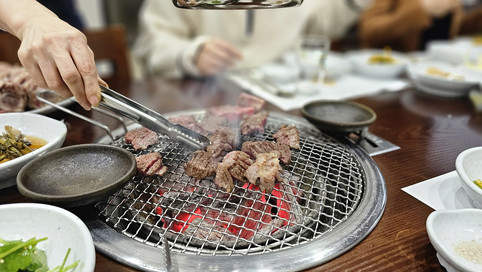Navigating Korean BBQ Etiquette: A Guide forTravellers
- Joanne Colman-Bown
- Sep 30, 2024
- 4 min read
Updated: Jul 29
Korean BBQ, or "gogi-gui," is a culinary experience that embodies the heart of South Korea's social dining culture. Participating in a Korean BBQ meal is as much about the interaction and etiquette as it is about the delicious food. Here’s a guide to help you navigate Korean BBQ etiquette during your travels in South Korea.
Choosing a Restaurant
Korean BBQ restaurants range from traditional, often family-run establishments to modern, upscale dining spots. Traditional places usually offer a more rustic, authentic experience, while modern ones might feature sleek décor and high-end cuts of meat. Some restaurants specialize in particular types of meat, such as beef (bulgogi or galbi) or pork (samgyeopsal). It's worth exploring different places to experience a variety of flavours.
Seating and Ordering
Korean BBQ is a communal meal meant to be shared. It's typically enjoyed in groups, making it a perfect opportunity for socializing with friends or family. There are a few places for solo diners, but in many, its a minimum 2 person order. When you order, it's common to select several different types of meat to share among the table. The server may recommend portions based on the size of your group.
While some restaurants have servers who will handle the cooking, in many places, grilling the meat is part of the experience. Usually, the person seated closest to the grill, often the eldest or the host, will take charge of cooking. Use the provided tongs to place the meat on the grill and flip it. Once the meat is cooked, it’s customary to use scissors to cut it into bite-sized pieces for easy sharing.
Eating Etiquette
A variety of side dishes, known as banchan, are provided with your meal. These are meant to be shared among everyone at the table. Common banchan include kimchi, pickled vegetables, and seasoned greens.
A popular way to enjoy your meat is to create a wrap using lettuce or perilla leaves. Place a piece of meat on the leaf, add some ssamjang (a savory dipping sauce), garlic, and perhaps a piece of kimchi or other banchan, then wrap it up and eat it in one bite.
Respecting Elders
Korean dining etiquette places a strong emphasis on respect for elders. Allow older members of the group to begin eating first, and often the youngest members of the group will serve the elders.
Drinking Etiquette
Korean BBQ meals are often accompanied by soju, a popular Korean alcoholic beverage. Pouring drinks for each other is a sign of respect and camaraderie. When pouring a drink for someone else, use both hands to hold the bottle, especially if the person is older or of higher status. When receiving a drink, hold your glass with both hands as well.
Before drinking, it's customary to make a toast. Say “geonbae” (cheers) and take a sip of your drink. Avoid drinking alone; always wait for others to join you.
General Tips
Using Utensils
In addition to chopsticks, Korean BBQ meals often involve the use of spoons, particularly for soups and stews that might accompany the meal. When not in use, rest your chopsticks on the provided chopstick rest or on the edge of your plate.
Try to take only what you can eat, as leaving a lot of leftover food is considered wasteful and disrespectful. Start by ordering just 2 or 3 portions of meat, a bibmbap or some boiled rice, and add to it as you go if you can eat more. This is the way you will see the locals orderi8ng too.
In many cases, one person will pay for the entire meal. If you're dining with locals, they might insist on covering the bill. If you want to contribute, offer to pay for a different meal or drinks later on.
My favorites!
Two opposite sides of the city, but I love...
853 (팔오삼)
16 Insadong 12-gil, Jongno District, Seoul
Operating hours: 11:30-22:00 (Last order 21:20)
I am not the easiest as I am gluten free and I travel with a vegetarian! but here we can both eat happily. Not only do they look after us, but if you dont have dietary needs they have great options. 853 is a pork barbecue restaurant located in a renovated hanok in Insa-dong, offering various cuts of pork such as Moksal (Grilled pork shoulder), Gabeurisal (Grilled blade-end fatback)and Samgyeopsal gui (Grilled pork belly). This has to be the best pork I have ever had! Every visit to Seoul means I need to go here.

Sam's Korean BBQ Restaurant
28 Samseong-ro 104-gil, Gangnam District, Seoul
Operating hours: Open until 21:00
Experiencing Korean BBQ is a delightful adventure that goes beyond just eating—it’s a way to connect with the local culture and people. By following these etiquette tips, you can enjoy a respectful and enjoyable meal that will leave a lasting impression. So fire up the grill, pour some soju, and immerse yourself in the rich and flavourful world of Korean BBQ.


















